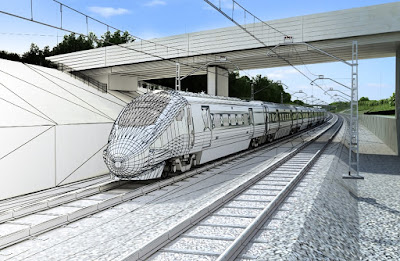HS2 in the Limelight
The final post today looks
at the company behind the massive HS2 infrastructure project that will see some
of the U.K.’s largest cities connected by a new high-speed railway system. We
have looked
fleetingly at the project before when we focused on the travails of
Carillion, just one of the firms tasked with seeing this large-scale project
realised. However, whilst Carillion is experiencing a period of difficulty at
the moment, the HS2 Company itself has this week been thrust into the limelight
because of its organisational structure, and its compensation to key
individuals. So, in this post, we will look at the developing story and assess
the development of this integral project.
High Speed Two, or HS2, is
the name given to the large-scale infrastructure project that aims to connect
Britain’s largest Cities by way of modern high-speed rail links and is
coordinated by the HS2 Ltd Company that is funded by grant-in-aid
from the Government. The project will see eight different cities connected,
with the stated aim being to ‘[rebalance]
our economy long before the trains start running’; the Company predicts
that HS2 will create around 25,000
jobs and fuel economic benefits totalling over £103 billion. However, ever
since the project was first declared, there has been a number of criticisms and
objections, relating to such aspects as the trains
running through certain areas, the structure and plans of the project, and the
spiralling costs, and recently the focus has turned to the financial side
of the project, with remuneration being chief amongst those. It was reported last
week that MPs were growing increasingly concerned certain staff members being
vastly overpaid by the Company, with some going as far to call for legal action
to be taken by the Government. So far, the most contentious element in this
regard has been the fact that the Company has paid out £2.76 million to 94
individuals in relation to redundancy payments, despite there being a statutory
cap of £1 million, something which has been labelled by MPs on the Public
Accounts Committee as ‘a
shocking waste of taxpayers’ money’. Yet, over the past week, the plot has
continued to thicken.
Last week it was reported
that the National Audit Office (NAO) found that the Company’s former Chief
Executive, Simon Kirby, had been expressly
forbidden from allowing the redundancy payments, or even just proposing
them in furtherance of the cap. Yet, the story goes that the email in question,
forbidding the payments, was not forwarded to the relevant members of the Board
and, upon investigation by the NAO, it was found that documents
were tampered with after the fact to cover up these ‘mistakes’. The Public
Accounts Committee were damning in their judgement, declaring that the Company ‘lacks
basic financial controls [which] heightened the risk of fraud and financial
errors’; today, that damning email came to light. The Guardian reported that Kirby was warned that even to propose
the pay-outs ‘would
cause enormous reputational damage to the company’, and that, for the
Department of Transport, ‘this
is an absolute RED LINE for us. Company employees are not civil servants. They
have to take the rough with the smooth’. So far, Kirby has suggested only
that he ‘did
not recall’ whether that email was forwarded to the Board, and that decision
to make employees redundant was taken after he had left; yet, these revelations
are extraordinarily damning for Kirby, and his destination post-HS2 raises
further concerns.
In one of the first posts here
in Financial Regulation Matters, we
looked at what seemed to be a culture of fraud, bribery, and essentially financial
negligence within one of the world’s most recognisable brands – Rolls-Royce; in
September 2016, Simon Kirby joined Rolls-Royce as its Chief Operating Officer,
with the firm declaring that the appointment was designed to ‘drive
operational and financial performance across the business…’. With MPs
concerned that Kirby ‘has
not been held to account for his actions’, the pressure is continuing to
build for Kirby and his new employer, as the smell of financial negligence will
certainly be unwelcome given that the firm is currently operating under the
largest ‘Deferred
Prosecution Agreement’ ever appropriated by a British agency (the Serious
Fraud Office) for bribery, fraud, and all-around financial negligence.
Nonetheless, whilst Kirby waits to find out whether that pressure results in
action, the knock-on effect for HS2 is severe.
In reality, the HS2 project
is an extremely expensive and precarious project, being executed at precisely
the time were increased expense and precariousness are not at all desired. In
this era where austerity continues and the country is facing an increasingly
uncertain economic future, projects such as HS2 need to be delivered with the
utmost integrity, and today’s latest developments represent a hammer blow to
that ideal. If, and one suspects it is more than likely, investigations
continue and find systemic issues, it
should be the case that the organisational elements of the Company are
thoroughly re-examined and altered accordingly; however, the reality is that
the Company will likely need much more than the £55 billion that it requires,
and this is the cause of the Government’s push to encourage foreign
investment from the likes of China – the question then is do the Government
dare tackle what may be systemic fraud and financial negligence in light of the
proposed reality that the project will need even more money from the public
fisc and/or foreign governments? The likely answer to that question is a
resounding ‘no’, and it is for that reason that Simon Kirby may not have
escaped the clutches of justice on this occasion; simply put, his actions
regarding the damning email make him the perfect ‘fall guy’ for what may be
systemic issues within the HS2 project.
Keywords – HS2, Fraud,
business, politics, investment, negligence, Department for Transport,
Rolls-Royce, @finregmatters





Comments
Post a Comment